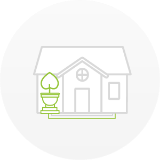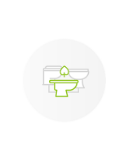Types of Composting Systems
As New Zealand's leading supplier of composting toilets, we have the biggest range of composting toilet technology in the country. Here is a look at the types of systems we supply:
Self-contained Systems (SCS)
Self-contained systems are on-floor systems in which the composting chamber is located directly inside the pedestal itself. Such systems require no sub-floor space to house composting chambers.
There are 3 types of self-contained systems:
1) All-in-one (AIO) Systems
All-in-one systems see both solids and liquids collected in the same chamber within the pedestal. Compost from these systems requires maturation in an on-site Secondary Treatment System.
There are 2 types of all-in-one systems:
All-in-one with leachate drain - all-in-one systems that collect solids and liquids in one composting chamber and have a leachate drain for excess liquids - this sees leachate drained into a soak-away. These toilets are fanned for ventilated.
See the product as an example:
All-in-one bucket system - all-in-one systems that collect solids and liquids in one composting chamber and do not have a leachate drain.
See the product as an example:
2) Urine Diversion (UD) Systems
Urine Diversion systems deal with solids and liquids separately. Solids are collected in a composting chamber within the pedestal, while urine is diverted to a soak-away (drain) or into a separate container. Compost from these systems requires maturation in an on-site Secondary Treatment System. Here are the 2 types of UD systems:
UD to soak-away (UD-S) - Solids are collected in a composting chamber, and urine is diverted to a soak-away (drain). These toilets are fanned for ventilated.
See the product as an example:
UD to container (UD-C) - Solids are collected in a composting chamber, and urine is diverted into a separate container. These toilets are usually fanned for ventilation.
See the product as an example:
- Sun-Mar™ | GTG™
- EcoLet™ | Separera Mini Urine Container (UD-C)
- CompoCloset™ | Cuddy Lite
- Trelino® | Evo S
- Trelino® | Evo M
- Trelino® | Evo L
Urine diversion systems (UD-S and UD-C) with agitator mechanism - solids are collected in a composting chamber with an agitator mechanism, and urine is diverted into a separate container. These toilets are usually fanned for ventilation.
3) Continuous Hybrid Processor (CHP) Systems
CHP systems are designed to achieve a composted final product that can be buried directly, not requiring the use of a Secondary Treatment System. Such systems compost in 2 stages - they have a primary processing chamber for wet composting, in which solid and liquid waste is processed, and a finishing tray for dry composting, into which composted material is deposited for maturation and removal.
We have 3 types of CHP systems:
Zero leachate, automatic, heated systems - heated models that evaporate leachate and do not require a soak-away. Solids and liquids are collected, automatically mixed and processed in the primary chamber. Composted material is deposited into the finishing tray for maturation and removal. 240V power is required for heating and ventilation.
See the product as an example:
Mechanical, heated systems - heated models that assist composting by keeping the compost at an optimum temperature. Solids and liquids are collected, mixed mechanically and processed in the primary chamber, and composted material is deposited into the finishing tray for maturation and removal. Some liquids are evaporated, but a leachate drain is required to drain excess liquids. 240V power is required for heating and ventilation.
See the product as an example:
Mechanical, non-electric (non-heated) systems - solids and liquids are collected, mixed mechanically and processed in the primary chamber, and composted material is deposited into the finishing tray for maturation and removal. The leachate drain is required to drain excess liquids. Low power requirement to operate the fan only (12V).
See the product as an example:
Split Systems (SS)
Split systems see a pedestal sit in the bathroom, connected via a chute/pipe to a composting chamber that sits subfloor. Split systems allow for well-sized composting chambers, making them lower maintenance than self-contained systems, as they do not need to be emptied as often.
There are 4 types of split systems:
1) Batching Processor (BP) Systems
Batching processor systems achieve a composted final product that can be buried directly, not requiring the use of a Secondary Treatment System. Composting is done in batching chambers on a rotational basis. One chamber is in service at any one time, meaning it is connected to the pedestal to collect solid and liquid waste. The chambers are double-walled, allowing for heat retention to facilitate composting. Excess liquids are drained through to the bottom of the chamber through perforated holes in the inner wall of the chamber, and out to a soak-away through a leachate drain. Once the in-service chamber is full, it is put aside for maturation and is replaced by an empty chamber that becomes the new in-service chamber. Once the contents of the first chamber have matured, they are ready for emptying. Once emptied, the chamber is ready to be placed back in service.
There are 2 types of batching systems:
Batching systems with mixing mechanism - batching systems with mixing mechanisms feature a mixing mechanism in the chambers. This speeds up composting by spreading composting bacteria throughout the compost pile. It also allows you to maximise the space in the chamber by levelling the compost mass, so that it does not remain conical due to waste being deposited in the middle via the chute. Chambers are double-walled, liquids drain to the bottom and out through a leachate drain into a soak-away. These systems are fanned for ventilation.
See the product as an example:
Batching systems without a mixing mechanism - batching systems that feature no mixing mechanism. This sees the mass take on a conical shape as waste is deposited in the middle of the chamber via a chute - manual levelling may be required. The composting chambers are double-walled, liquids drain to the bottom of the chamber and out to a soak-away through a leachate drain. These systems are fanned for ventilation.
See the product as an example:
2) Continuous Processor (CP) Systems
Continuous Processor systems are designed to achieve a composted final product that can be buried directly, not requiring the use of a Secondary Treatment System. Such systems are well-sized and are therefore the lowest maintenance systems available, not requiring frequent emptying. They feature a single composting chamber that sits sub-floor directly underneath the pedestal, and achieve compost processing through a large compost mass and time-in-retention (TiR). The compost mass is retained in the upper part of the chamber. As the compost decomposes and matures, it shrinks in volume and moves passively into the lower part of the chamber for removal. Retention time is 1-2 years, from fresh to old. Continuous processor systems are fanned for ventilation and feature a leachate drain for excess liquids. Composting chambers can be partially buried.
See the product as an example:
3) Continuous Hybrid Processor (CHP) Systems
CHP systems are designed to achieve a composted final product that can be buried directly, not requiring the use of a Secondary Treatment System. Such systems compost in 2 stages - they have a primary processing chamber for wet composting, in which solid and liquid waste is processed, and a finishing tray for dry composting, into which composted material is deposited for maturation and removal. These systems are fanned for ventilation and feature a leachate drain for excess liquids.
We have 4 types of these systems:
Mechanical, heated systems - heated models that assist composting by keeping the compost at an optimum temperature. Solids and liquids are collected, mixed mechanically and processed in the primary chamber. Composted material is deposited into the finishing tray for maturation and removal. Some liquids are evaporated, but a leachate drain is required to drain excess liquids. The composting chamber is located sub-floor, directly underneath the pedestal. 240V power requirement for heating and ventilation.
See the product as an example:
Mechanical, non-electric (non-heated) systems - solids and liquids are collected, mixed mechanically and processed in the primary chamber, and composted material is deposited into the finishing tray for maturation and removal. The leachate drain is required to drain excess liquids. The composting chamber is located sub-floor, directly underneath the pedestal. Low power requirement to operate the fan only (12V).
See the product as an example:
- Sun-Mar™ | Centrex 2000 NE (non-electric) - A/F (air flow)
- Sun-Mar™ | Centrex 3000 NE (non-electric) - A/F (air flow)
Mechanical, heated systems with micro flush - models in which the composting chamber is connected to the pedestal via pipe, transferring waste to the composting chamber via micro flush. This means the composting chamber can be placed away from the pedestal. The flushing mechanism features a ball-cock bowl, in which a lever is lifted to add water, and pushed down to siphon flush. Water usage: ave. 650ml rinse for pees, ave. 1.5L flush for poos (depending on flooding of the bowl). The heating elements in the composting system facilitate composting by keeping the compost at an optimum temperature. Solids and liquids are collected, mixed mechanically and processed in the primary chamber, and composted material is deposited into the finishing tray for maturation and removal. Some liquids are evaporated, but a leachate drain is required for excess liquids. 240V power requirement for heating and ventilation.
See the product as an example:
Mechanical, non-electric (non-heated) systems with micro flush models in which the composting chamber is connected to the pedestal via pipe, transferring the waste to the composting chamber via micro flush. This means the composting chamber can be placed away from the pedestal.The flushing mechanism features a ball-cock bowl, in which a lever is lifted to add water, and pushed down to siphon flush. Water usage: ave. 650ml rinse for pees, ave. 1.5L flush for poos (depending on flooding of the bowl). In these systems, solids and liquids are collected, mixed mechanically and processed in the primary chamber, and composted material is then deposited into the finishing tray for maturation and removal. A leachate drain is required for excess liquids. Low power requirement to operate the fan only (12V).
See the product as an example:
- Sun-Mar™ | Centrex 2000 NE (non-electric) - M/F (micro flush)
- Sun-Mar™ | Centrex 3000 NE (non-electric) - M/F (micro flush)
4) Solar Desiccation Drying (SDD) Systems
Solar Desiccation Drying systems dry urine and solids, and require no addition of bulking materials. These systems achieve evaporative function through the solar thermal chimney at the back of the unit, which provides radiant heat to the chamber as well as a thermal climb that passively draws air up through the chimney in conjunction with the wind-driven vent. The systems are power-free, and the wind-driven vent is placed at an elevation above the building to maintain evaporation through air movement. Solar Desecration Drying systems are preferably positioned in places with good solar index. In colder climates, solar cell-powered options are available to maximise drying, with the addition of a solid-state heating element - this is a battery-free solution; however, a battery can benefit the application of lighting in the building. In places of low air movement, an electric fan can be added for fan-forced ventilation. Urine diversion (UD) can also be added to assist drying, seeing urine treated via a different filter mechanism before reaching the environment.
See the product as an example:
*We code our systems according to the above acronyms. As an example, a Kazuba Tank System is defined as the following system type: SS-SDD-AIO (Split System - Solar Desiccation Drying - All-in-one).
Need help choosing a system? Call WCTNZ® on 0800 022 027 for free advice on system specification and setup. Advanced design consultancy services are also available.
Copyright © 2025 Waterless Composting Toilets NZ Limited (WCTNZ®). All rights reserved.
This content has been reviewed and approved by Dylan Timney, Managing Director of WCTNZ®, who brings over 17 years of composting toilet expertise and 16 years of experience in building and eco-construction in New Zealand.
Last reviewed: July 10, 2025














